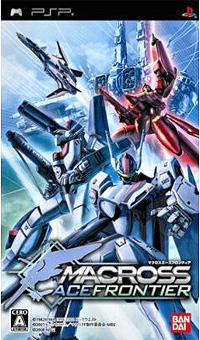 What with the latest TV series, Macross Frontier, finishing a fairly recently ago and the new PSP game Macross Ace Frontier being released with another on the way, it seems that now is a good time to talk about a series that has often been given a somewhat unfortunate gaming treatment.
What with the latest TV series, Macross Frontier, finishing a fairly recently ago and the new PSP game Macross Ace Frontier being released with another on the way, it seems that now is a good time to talk about a series that has often been given a somewhat unfortunate gaming treatment.
Of all the mecha franchises out there Macross is one of the most badly represented. This isn’t because developers want to sabotage the series but more down to the fact that each Macross game is actually comprised of three disparate gaming genres all vying for dominance via one control method.
To clarify, Macross is a series based around love triangles, giant aliens, music and, of course, planes that can transform into large robots. Naturally, each game focuses on these variable fighters, which results in a game that has to offer control for each of it’s three modes; fighter, GERWALK and battroid.
To say that that this is a pretty tough undertaking isn’t in any way an understatement. It’s actually, almost utterly impossible.
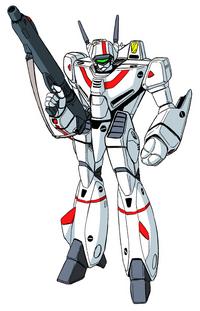 The annals of Macross gaming are pretty extensive but this column will only be covering the more recent 3D efforts. This is not to say that the older 2D shoot-em-ups aren’t worthy of discussion, as the PC Engine versions were developed by none other than NCS who created the incredibly influential Assault Suits series, but that the problems with the various modes of transformation only reared their head once greater functional (3D) scope became available. As such, I apologise that this is a somewhat of a selective breakdown rather than anything exhaustively thorough.
The annals of Macross gaming are pretty extensive but this column will only be covering the more recent 3D efforts. This is not to say that the older 2D shoot-em-ups aren’t worthy of discussion, as the PC Engine versions were developed by none other than NCS who created the incredibly influential Assault Suits series, but that the problems with the various modes of transformation only reared their head once greater functional (3D) scope became available. As such, I apologise that this is a somewhat of a selective breakdown rather than anything exhaustively thorough.
It also goes without saying that I won’t be covering the numerous Robotech games, not out of blinkered otaku tendencies but because the faults that befall the newer Macross games are equally present in the Robotech editions (in some instances, even more so).
So why is it so bloody hard to get a variable fighter working in-game? Well, it’s down to the aforementioned three modes that they can transform between; fighter, GERWALK and battroid.
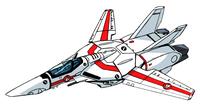 Fighter mode is basically a plane so any functional tenets from flight simulators are an easy match. Battroid mode is your nimble Japanese mecha and, as this column has shown, that genre has a lot of reference material already. Switching between these two modes would be do-able and wouldn’t require a complex control scheme, however there is one more mode left.
Fighter mode is basically a plane so any functional tenets from flight simulators are an easy match. Battroid mode is your nimble Japanese mecha and, as this column has shown, that genre has a lot of reference material already. Switching between these two modes would be do-able and wouldn’t require a complex control scheme, however there is one more mode left.
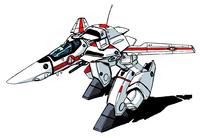 GERWALK, a wonderful acronym that stands for: Ground Effective Reinforcement of Winged Armament with Locomotive Knee-joint. Basically, it’s a halfway house between fighter and battroid. To explain, the legs come down and the arms pop out but the main body remains that of a plane. Interestingly, the mecha designer responsible for the variable fighter design, that of Shoji Kawamori, actually came up with this mode first. On a skiing trip he noticed how jumpers legs dangled in mid-air and wondered how that would work on a plane. GERWALK, as such, is the crux of the variable fighter’s capabilities as it allows the high speed pursuit of fighter mode but also the VTOL capabilities seen in battroid. This is also where the functional problems start.
GERWALK, a wonderful acronym that stands for: Ground Effective Reinforcement of Winged Armament with Locomotive Knee-joint. Basically, it’s a halfway house between fighter and battroid. To explain, the legs come down and the arms pop out but the main body remains that of a plane. Interestingly, the mecha designer responsible for the variable fighter design, that of Shoji Kawamori, actually came up with this mode first. On a skiing trip he noticed how jumpers legs dangled in mid-air and wondered how that would work on a plane. GERWALK, as such, is the crux of the variable fighter’s capabilities as it allows the high speed pursuit of fighter mode but also the VTOL capabilities seen in battroid. This is also where the functional problems start.
With this extra mode sandwiched between fighter and battroid, the controls have to offer a new disparate control scheme. At worst this means that each mode ends up with a massively different set of control inputs, making the learning curve suitably counter-intuitive.
Macross Digital Mission VF-X (PlayStation)
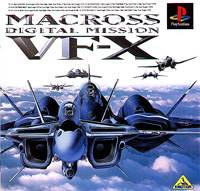 This is where the 3D games start; with UNiT’s abortive VF-X games. The first game was set around the same time frame of Macross 7, so the roster of available variable fighters was pretty extensive. It also featured, for the first time ever in fact, a fully transformable VF-4. Something had never been since it was introduced in fighter mode way back in Macross Flashback 2012. All in all, it was shaping up to be every Macross fan’s dream.
This is where the 3D games start; with UNiT’s abortive VF-X games. The first game was set around the same time frame of Macross 7, so the roster of available variable fighters was pretty extensive. It also featured, for the first time ever in fact, a fully transformable VF-4. Something had never been since it was introduced in fighter mode way back in Macross Flashback 2012. All in all, it was shaping up to be every Macross fan’s dream.
Then it got released.
After multiple agonising delays, VF-X hit the shelves. It had a wondrous opening FMV with Fire Bomber singing Try Again and animation by GONZO. The front end was stylised a la Macross Plus and then the game started. Oh…dear.
The first problem was that because this game was in 3D the developer, UNiT, couldn’t resist showing the animation sequence for each transformation. So you’d have the controls wrenched from you as your variable fighter transformed. Thankfully, you were invulnerable during this phase but comedically this oversight could be used to break the game until it was made farcically easy.
The second problem was a mixture of a badly implemented GERWALK mode and a neutered battroid mode. In the case of the latter, battroid mode was unable to fire missiles, which whilst inaccurate to the anime was also functionally frustrating and limited the usefulness of the mode.
GERWALK was a mess though and sat between the two other modes, meaning that the player had to toggle through each mode rather than select them individually. The reason why it didn’t work was down to the means in which your variable fighter gained and lost height. Thrust for the other modes was almost reversed in GERWALK, in that in order to gain height you had to pull down on the d-pad. On its own, it made sense but between the other two modes it just jarred. Couple that with the surreal choice to have the player strafe in GERWALK when not applying thrust and then allowing them to turn once the boosters were activated, meant you often over shot your target. The camera also had a habit of looking straight down in GERWALK, which was almost inevitable as it was tied to the player gaining altitude.
All in all, the first VF-X game was a pretty rocky start to the 3D generation of Macross games.
Macross VF-X2 (PlayStation)
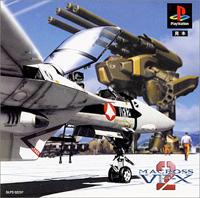 This was a direct sequel to the original VF-X and whilst UNiT were still onboard it was clear that Bandai was ghosting a lot of the development. Overall, VF-X2 was actually pretty decent. The camera got a re-working allowing the player to track targets despite their actual orientation and a more consistent control configuration.
This was a direct sequel to the original VF-X and whilst UNiT were still onboard it was clear that Bandai was ghosting a lot of the development. Overall, VF-X2 was actually pretty decent. The camera got a re-working allowing the player to track targets despite their actual orientation and a more consistent control configuration.
GERWALK still caused problems however, as it had certain additional functional nuances that jarred with how the other modes worked. Admittedly, it wasn’t anywhere near as bad as the hellish nonsense seen in VF-X but it was cumbersome enough to avoid using the mode most of the time. Battroid mode also still couldn’t fire missiles, bizarrely.
All that aside, VF-X2 was pretty compelling and visually it was a massive improvement. This was also one of the first Macross games to see a potential Western release but due to the complex rights issues associated with Macross outside of Japan (courtesy of Robotech), it never made the jump. There is a limited edition demo available, featuring a playable VF-5000B, but it goes for crazy money these days (if you can find it).
Separately, VF-X2 actually played an important narrative role in the Macross saga as a whole. Set in 2050, it laid the groundwork for the formation of privately funded military organisations, such as SMS in Macross Frontier occurring 9 years later, due to the inherent corruption of the government military. It also had a similarly fantastic opening FMV.
Macross Plus Game Edition (PlayStation)
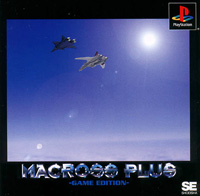 By this point Bandai had probably had enough with UNiT. So they looked elsewhere and found Shoeisha. Weirdly, they went with a dedicated Macross Plus tie-in rather than a series catch all. Of all the series Macross Plus was one of the least successful in Japan and considering the difficult rights issues abroad, the game would never have been able to be released anywhere else but Japan. Still, they went ahead with it and the result was moderately impressive.
By this point Bandai had probably had enough with UNiT. So they looked elsewhere and found Shoeisha. Weirdly, they went with a dedicated Macross Plus tie-in rather than a series catch all. Of all the series Macross Plus was one of the least successful in Japan and considering the difficult rights issues abroad, the game would never have been able to be released anywhere else but Japan. Still, they went ahead with it and the result was moderately impressive.
It’s also worth pointing out here that Shoeisha flat-out cheated in terms of offering the full gamut of variable fighter control. The game was actually split into two parts; aerial missions and ground based missions. In the aerial missions you played with fighter mode and in the ground based missions you played with battroid. So where were the transformation capabilities seen in the VF-X games?
Well, these had been relegated to quick time events. Specifically, when a missile volley was headed your way you would get a prompt to press X this would then kick off a cutscene of your variable fighter transforming into another mode and dispatching the missiles. Technically, GERWALK was present as a mode in this game but not one you could directly control.
It was a shrewd move as it meant the other two modes received a far more cogent functional treatment. It also looked rather lovely and what with Yoko Kanno’s seminal orchestral score playing in the background, it felt more inline with the host work.
Macross M3 (Dreamcast)
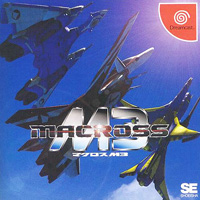 After the previous Macross game, you’d think Shoeisha were onto a near winning formula and wouldn’t drastically change their approach. Wrong. Macross M3 was close to a carbon copy of VF-X. In that it allowed the player to transform into any mode during gameplay, rather than separating the modes out in different gaming segments.
After the previous Macross game, you’d think Shoeisha were onto a near winning formula and wouldn’t drastically change their approach. Wrong. Macross M3 was close to a carbon copy of VF-X. In that it allowed the player to transform into any mode during gameplay, rather than separating the modes out in different gaming segments.
It almost worked as well. The transformation was handled on the d-pad and movement on the analogue (something Artdink shrewdly copied on the recent Macross Ace Frontier but more of that later) and a simpler approach to acquiring a missile lock (you just held down A when the enemy was in your targeting reticule and at the appropriate range). However, the camera setup was appalling as it placed the variable fighter squarely in the player’s field of view making it very hard to track targets. GERWALK also received its perennial functionality, with different controls for that mode and an inability to look up. Battroid mode could fire missiles though, so that was at least something.
This also had a wonderful opening FMV and filled in the gap on Max and Myria’s history prior to Macross 7. It also featured a slew of the more esoteric variable fighters that hadn’t been seen in animated form. Anyway, M3 sealed the fate of Shoeisha’s involvement with the Macross franchise and this was, thankfully, the last game they did.
Choujikuu Yosai Macross (PlayStation 2)
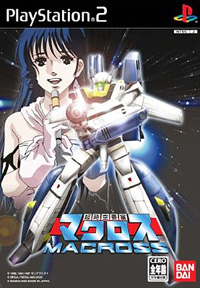 This is when things started to change for the better. Bandai approached SEGA AM2 for starters, which can only bode well. This was down to SEGA having access to the tech behind the popular Aerodancing games and Bandai hoped that having that arcade flight simulator would work well with Macross.
This is when things started to change for the better. Bandai approached SEGA AM2 for starters, which can only bode well. This was down to SEGA having access to the tech behind the popular Aerodancing games and Bandai hoped that having that arcade flight simulator would work well with Macross.
It worked very well in fact, SEGA’s Macross game is to date probably the most accomplished of all the dedicated Macross tie-ins. Unlike the games that preceded it, AM2 picked a base mode that the other two hinged off. Due to the usage of the Aerodancing engine the main mode was that of fighter, so the base dog fighting combat worked beautifully.
However, all was not sublimely wonderful. Even with the flight simulator focus, GERWALK did still cause problems. Requiring a mysterious new control configuration for gaining and losing altitude, one that wasn’t used in the other modes to boot. Battroid mode also lost its ability to fire missiles, again. That being said, the game did play well for the most part and some of the final missions were suitably epic.
Bizarrely, a far bigger roster of variable fighters was planned (namely those from Macross Plus and Macross Zero) but these were pulled prior to release. This may be down to the narrative focus being on the original TV series and movie, as such the added continuity was probably deemed too confusing.
Another Century’s Episode 2 and 3 (PlayStation 2)
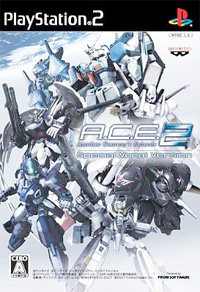 Now I’ve already covered the first two games in this column but whilst the ACE series isn’t solely dedicated to Macross it did offer some of the best variable fighter controls yet seen. Like the AM2 game that preceded them, both ACE 2 and 3 had a specific mode focus. Instead of being based on a flight simulator engine, ACE was always based around mecha combat. Unsurprisingly, the variable fighters had this imposed on them as well. The result was a far better approach to GERWALK mode and a seamless control configuration for all three modes.
Now I’ve already covered the first two games in this column but whilst the ACE series isn’t solely dedicated to Macross it did offer some of the best variable fighter controls yet seen. Like the AM2 game that preceded them, both ACE 2 and 3 had a specific mode focus. Instead of being based on a flight simulator engine, ACE was always based around mecha combat. Unsurprisingly, the variable fighters had this imposed on them as well. The result was a far better approach to GERWALK mode and a seamless control configuration for all three modes.
In ACE2 the emphasis was more on the mecha combat and whilst fighter mode didn’t get used it was a tad clunky. This was also true for all the transforming mecha that had a flight mode attached to them. In ACE3 this changed and a new more responsive flight mode was offered. This had a better camera setup as well and generally improved the variable fighter handling, as fighter mode became more viable.
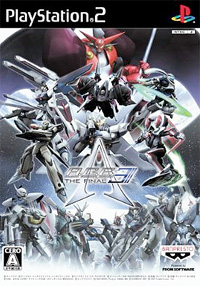 Ultimately, what made the handling work was that GERWALK was treated as a similar mode to the other two. Admittedly, the games were still weighted towards the mecha end of the spectrum but GERWALK was finally viable. It was faster than battroid but slower than the fighter, it sat between the two as a stopgap offering further graded functionality.
Ultimately, what made the handling work was that GERWALK was treated as a similar mode to the other two. Admittedly, the games were still weighted towards the mecha end of the spectrum but GERWALK was finally viable. It was faster than battroid but slower than the fighter, it sat between the two as a stopgap offering further graded functionality.
Specifically, GERWALK acted as the VTOL jack-of-all-trades it was always intended to be. Battroid mode was meant for the heavy mechanical take downs and the fighter as a way to cross the huge mission areas quickly. GERWALK sat between the two and aided the mid range combat in a beautifully organic fashion, as it had enough potency and speed to keep the enemy at bay without ending up as a massive mechanical target,
On their own, the variable fighters depicted in ACE were a finer and more accurate representation compared to almost all that had preceded it. This was down to From Software’s expertise in the mecha genre more than anything else.
Macross Ace Frontier (PlayStation Portable)
 So where does this leave us? It’s clear that approaching Macross with more its mecha in mind is obviously the better route to take but is that all? Well, Artdink have made a name for themselves recently with their Gundam Battle franchise (also covered previously in this column). Their focus and tech is very much suited for handheld mecha games but could they pull it off with a mecha that has two other disparate modes?
So where does this leave us? It’s clear that approaching Macross with more its mecha in mind is obviously the better route to take but is that all? Well, Artdink have made a name for themselves recently with their Gundam Battle franchise (also covered previously in this column). Their focus and tech is very much suited for handheld mecha games but could they pull it off with a mecha that has two other disparate modes?
In short, yes. They pulled it off quite well in fact, almost too well though more of that later. Remember the usage of the d-pad in Macross M3 to change modes? Artdink used something similar for Ace Frontier by having the analogue nub select each mode specifically (so no cycling through the modes basically). They also retained the camera viewpoint seen in VF-X2 and Macross Plus Game Edition. All that aside, like the ACE games, the game’s focus is very much on the mecha. This means that GERWALK acts as a halfway house between the too modes.
However, Artdink took it upon themselves to create two new problems with GERWALK mode. In the original anime, GERWALK mode can skim across vertical surfaces due to it’s VTOL configuration. Ace Frontier offers this functionality, which probably sounds fantastic but ends up being very not. To clarify, when you’re in an enclosed space and switch to GERWALK you often end up attaching to a vertical wall. This plays merry havoc with the camera and can cause the player to actually get stuck on geometry. Not entirely brilliant that. Secondly, GERWALK mode has a bizarre way of losing altitude The X button normally generates an upward thrust in GERWALK and Battroid modes, but to go downwards you have to double tap the X button and hold. In a frenetic dogfight it’s not uncommon to yo-yo in terms of your altitude when in GERWALK. Not exactly great that.
The above probably sounds more damning that it is but GERWALK is still causing problems but more down to Artdink’s zeal at trying to replicate functionality that nobody in their right minds had tried to do previously.
For a PSP action game though, Ace Frontier puts a lot of games to shame (especially the earlier console iterations listed above).
Dedicated to all pioneers…
I’ve probably been a tad disparaging throughout this edition of the column and whilst these faults are very much present in the games I’ve covered, it is by no means the direct fault of the developers themselves.
They’re doing their best to reproduce something that is purely aesthetic. Ichiro Itano’s mecha choreography has a lot to answer for, both good and bad (again, I’ve covered this before in the column). The issue here is that everyone has forgotten where the variable fighter came from; that of gangly ski jumpers and the thought of “what if a plane had legs?”.
Well, not so much forgotten but conveniently omitted I suppose. After all, how many decent 3D arcade helicopter games can you think of?

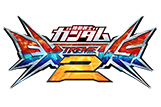
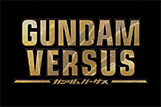








There was a mass production demo disc for VF-X2 included in the PS1 Macross:DYRL side-scrolling shooter. IMHO, it had the best GERWALK mode control of all these Macross games I’ve played to date.
The control for GERWALK was different than the released version of VF-X2. It’s been a while, but I believe in the demo, if you have a target locked on, the analog stick with the combination of L/R button allowed you to strafe the locked-on target. While analog stick alone will pan/tilt the nose of the gerwalk, allowing some degree of freedom to dodge incoming missles.
The published version of VF-X2 had this control removed, greatly reduced the tactical advantage of using GERWALK mode.
You didn’t cover the Robotech game? I know Robotech doesn’t get much recognition from anime fans, but the game itself was fairly fun.
The fighter mode basically handles like an arcade flight game like Rogue Squadron, rather than having more realistic flight controls like Ace Combat. It could also drop flares to counter missiles.
The battroid mode was also fairly straight forward, you walk, shoot, and could sort of hover and float with boosters. There was also a sniper but that wasn’t really useful in actual fights. Mostly it was used in specific ground based levels, but you could also use it more creatively to make quick turns or shoot down incoming missiles when you ran out of flares.
Finally the Gerwalk mode offered an alternate form to use in the ground missions, since it could shoot missiles, which the battroid form couldn’t do. It also had the ability to pick up items, like containers or people as required by missions, which happens in the anime a lot. For some reason the battroid couldn’t pick up people, but it does make sense that you would rather use the Gerwalk form to make deliveries. The final difference was that the missiles it shot were weaker, but more agile in the air.
It’s not “Macross” technically, but its take on variable fighters is still worth a look.
I’ve played both console Robotech games and omitted them from this feature on account of them not being part of the Macross saga.
I have laid out the perfect control scheme setup for all 3 VF modes for an Xbox 360 and PS3 control pad.
This scheme is based on how we play recent 3rd-person HD shooter games, factoring in the physics of atmospheric and zero-gravity environments, and how Japanese action controls are mapped as well as control intuitivity during fast-paced gameplay. It also takes into account that mecha are more or less giant ‘people’ with lag in relation to their mass and form. And that several other robot have no choice but to move like lumbering mechs because of the same reasons.
The controls are ideal for sandbox style gameplay.
These are the games whose control schemes I studied to come up with the perfect scheme: Ace Combat 6, Colony Wars, Star Wars Rogue Squadron, SDF Macross (PS2), Metal Gear Solid 4, Splinter Cell Conviction, Grand Theft Auto IV, Vanquish, A.C.E. 3, Anubis, Border Break, Modern Warfare, Gears of War, Dead Space, Orbiter (PC), Shattered Horizon, DropShip, Lost Planet & Transformers: War for Cybertron.
These games listed above have control elements that, when integrated and mapped out in the right places on a current HD console pad, will create an intuitive cohesive universal control scheme for a multi mode vehicle in a real-time fast-paced action game. This scheme also takes into consideration gameplay as a person, maclone, destroid, and nousjadel.
I’ve been at this for a long time, so if anybody is interested in them send me a mail.
Wow, thanks for the contribution Prrrowr. You sound like you’re selling something (the secrets of success inside: just click this link!). Seriously though, this is what the control scheme should be: Fighter mode should control like ace combat, with the left stick controlling roll and pitch, and the left trigger and bumper (or L2 and L1) controlling throttle. The right stick would be used to look around, and you could even have a reticle to lock-on to enemies behind you or shoot you turrets (look at the fight between Max and Miria in DYRL). D-Pad can control transformations. Gerwalk mode’s speed should be much slower. It would essentially be like controlling an FPS or TPS character, with the left stick moving you front-back-left-right, and the right stick used for aiming (free aim btw, no lock-on, or at least Armored Core 1-style lock-on, where the enemy has to be inside a medium-sized reticle for you to lock onto him). It would be most like Descent or a space combat game (or spectating in an FPS) in that if you aim up and press forward you will fly up. RT and RB would be used to move up and down in the Y axis. The movement should be very floaty, with a lot of inertia when you stop moving. but its advantage is its added manoeuvrability (since a fighter jet’s turning angle can only be so sharp). Disadvantages are the fact that it can’t turn as fast as Battroid mode and can’t manoeuvre as well in tight spaces, i.e. corridors, etc… (due to it’s speed, turning speed and the inertia of its movement). Battroid mode’s speed would be even slower than Gerwalk’s, but the advantages are minimal inertia (giving you the greatest degree of control), instant turning speed and, due to those factors, best ability to shoot down oncoming missiles with the MG. Vertical movement would still be controlled with LT and LB. You can also implement some kind of melee combat. Also Battroid mode will have the lowest collision damage. For space combat all you would have to do is increase the inertia (unless you say the VFs have automatic compensators, or whatever, in which case you could even decrease it). Possible strategies right off the top of my head: go from fighter to Battroid, let a pursuing jet overtake you and lead it with your MG as it goes past.